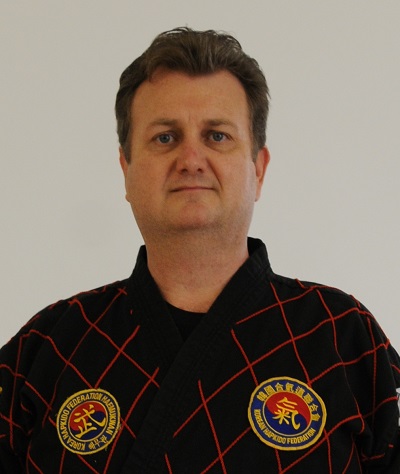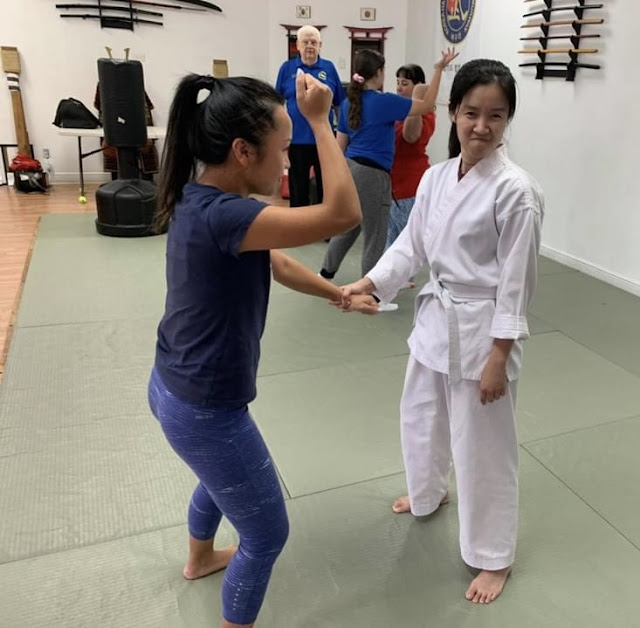
Living in 🇵🇭 | Eczema Survivor 💪 | Food Adventurer 🍜 Craft Lover ✂️ | Passionate Virtual Assistant 💻 📩 For sponsorships, collabs, or press inquiries: info@usanewstodayworld.com
Wednesday, October 2, 2024
Ten Teaching Tips by KJN Ronald W. Stone

Fostering a Supportive Culture in Your Martial Arts School by Richard Hackworth

Women Learn Leadership Skills by Instructor Ma

10 Ways to Increase Female Participation in Hapkido Classes by Instructor Ma

Five Reasons to Become a Certified Taekwondo Instructor Under The Leadership of my Organization by KJN Jong Sung Kim

From Military Brat to Martial Arts Master: The Incredible Journey of Kevin Dewayne Hughes
Kevin Dewayne Hughes
Tenkidokan Kancho
🟡Informal Martial Arts Training
I began my martial arts training at an early age. From as early as I can remember, my father taught me stuff. Now, he wasn't a martial artist in the sense of a karateka or what not. He was special operations in the US Air Force, Combat Control. I remember him showing me basic punches and kicks with the occasional modern military weapon.
One day, he set up an obstacle course for our dog, SB (Poo for Brain) to run through. He was teaching me how to set up trip wires. SB ran the course and sprung the trip wires, and each trip wire was attached to a different colored smoke grenade as a proxy for a fragmentation grenade
I would not begin formal training until July of 1988. Regardless, I got fundamental training from my dad and supplement training when I could. For example: When we lived on Rhine-Meine Air Force Base, there was a Shotokan Karate Dojo that meet after school in a building next to the school. I would watch the classes after school and practice what I saw at home.
🟡Formal Martial Arts Training
I was living in Olympia, Washington when I began my formal training. This was in Olympic TaeKwonDo under Yong Hawk Lee, a high ranking Korean Black Belt. I trained there until I sustained a hip injury during hyper flexibility training at the dojang. Sadly, this injury still haunts me to this day.
September of 1988 I began training in Okinawan Matsumura Seito Shorin-ryu Karate under Bill Marken. Now Marken had lineage to Hohan Soken through his teacher Dwight Stewart who trained with Fusei Kise, Seisho Kenjo, and Hohan Soken (when Kise would take his students to Soken's dojo).
During my time at Marken's Dojo, my brother Douglas Hughes, kept training at the TaeKwonDo Dojang. So he would teach me what he was learning from Lee and I would teach him what I was learning from Marken. After a while, my brother switched over to Shorin-ryu.
Marken's Shorin-ryu was a mix of striking and aikijujutsu like grappling reminiscent of Okinawa-Ti. There was also Kobujutsu with bo, sai, kama, and tonfa as well as a small emphases on the elusive Hakutsuru Kempo. Unfortunately, Bill Marken only had one kata of the Hakutsuru.
In time, Marken met Jerry Gould who was the USA Chief Instructor for Shobayashi Shorin-ryu. Marken's Dojo switched over to Shobayashi Shorin-ryu and I became a direct student of Jerry Gould. The Shobayashi system was a mix of striking, grappling more like the Jujutsu that Kano Jigaro would have learned, and weapons use. The weapons taught were bo, sai, tonfa, kama, nunti bo, eku bo, and tekko.
Although, I and Bill Marken were now students of Jerry Gould and Shobayashi Shorin-ryu, I got requests from previous Matsumura Shorin-ryu students for instruction. They asked me for two reasons: One, was because Bill Marken didn't want to teach Matsumura Shorin-ryu anymore. Two, I was one of the assistant instructors at Bill Marken's Dojo when we made the switch from Matsumura to Shobayashi. In response to the requests, I opened a small dojo in the Olympia, Washington area teaching Matsumura Shorin-ryu to those who wanted while studying Shobayashi Shorin-ryu with Jerry Gould in Renton, Washington.
When I was 19, I joined the US Army as a Chaplain Assistant. I got some additional military grade combat training plus the cool position of being the chaplain's body guard. I met some martial artists at basic and advanced training and we did exchange training on our days off.
The US Army then stationed me in Idar-Oberstein Germany. Here I taught a Shorin-ryu class out of the base gym. On Mondays and Wednesdays, I would attend Wing Chun lessons with Eingen Schuelter, a student of Leung Ting (a controversial student of Ip Man). Tuesdays and Thursdays, I would attend Shotokan Karate classes. In addition, the Roman Catholic Chaplain at the base was a Preying Mantis KungFu practitioner, who attended the Wing Chun classes with me. Of Saturday's the Chaplain and I would get together to practice Wing Chun and exchange train.
When I returned home from the US Army, I resumed my attendance at Gould's Dojo and joined an ITF TaeKwonDo Dojang and a Yoshin-ryu Jujutsu Dojo under Tanemura. I trained at these schools for three years while I completed a degree in Electrical Engineering Technology.
When I completed the degree, Intel corporation hired me and moved me to the Portland, Oregon area. Here I opened a Shorin-ryu dojo and trained in many different martial arts school. Some of the styles I trained in Portland were: Chubu Shorin-ryu, Ryobukai, FMA, Hung Gar and others. I also trained for a while with Mikio Nishiuchi in Matayoshi Kobudo, Pangai Noon Ryu, and Eishin-ryu Iaido, but he was far away and I could only train with him once a month on my four day weekend. Portland, Oregon is also where I began my TaiChi journey in Tung style TaiChi.
From Portland, Oregon, I moved to Decatur, Illinois where I opened another Shorin-ryu Dojo. While living in Illinois I met Jim Gaines who was a student of Yuichi Kuda, a student of Hohan Soken. He also trained Hakutsuru (white crane) Kempo via Kuda and the Hakutsuru of Gokenki via the Shito-ryu of Kenwa Mabuni. He also did Goju-ryu and Uechi-ryu along with Aikijujutsu. It was Jim Gaines that I got my Kyoshi licence from.
While living in Illinois, I switched from Mikio Nishiuchi to Franco Sanguinetti for Matayoshi training and through him, I met Rosenberry for additional Goju-ryu training in the Toguchi line. Both of them I had to schedule travel to go see them like I did Nishiuchi.
Also, while living in Illinois, I met Del Garrett, who taught a style called Kenjukido and it appeared to be a mix of Kajukenbo and Parker's American Kenpo. I earned an 8th Dan from him in it. I mention this as he was also one of my mentors that helped me get into publishing books as he was an award winning author.
Another person I met during this time in my life was Ron Shively, who I got additional TaiChi and KungFu training as well as exposure to Filipino martial arts.
Joseph Slonski is another person I met during this time who gave me additional directions in martial arts and his Shorei Goju-ryu.
Although I was teaching Shobayashi Shorin-ryu while in Illinois, people would see me practicing Jujutsu, TaiChi, or KungFu and they would beg me to teach them. After a while, I relented and started teaching what I had learned in other styles to those who wanted the knowledge.
In November of 2018 I moved to the Philippines. While in the Philippines, I have joined with Ron Goninon who is under Takaya Yabiku, a student of Hohan Soken. Goninon also inherited and is the current head master for Buto-ryu Tsuruken. I have been appointed the Philippines head for both Matsumura Shorin-ryu and Buto-ryu under Ron Goninon. Although I am the Philippines head for these two styles, I am willing and able to teach them to people anywhere in the world.
🟡 Beyond Martial Arts
In addition to martial arts, I also teach Yoga and QiGong. The QiGong I teach is an amalgamation of the QiGong taught in TaiChi and the various KungFu schools I have attended. The Yoga also started as yoga taught in some of the KungFu schools and my efforts eventually attracted the attention of a Himalayan Yogi in India that took me on to mentor me further in Yoga.
🟡 Other Martial Arts Organizations
I run a school called Tenkidokan, which means the place of the way of heavenly energy or the place of the way of weather. Either translation is fine as both convey the philosophy of the school. It is not a martial arts style, it is just a school in which martial arts are taught, such as the Matsumura Shorin-ryu and the Buto-ryu Tsuruken. Yoga, QiGong, and Fitness are also taught in this school.
I am the vice president of the Kokusai Dento Karate Kobudo Rengonkai, an organization in Pakistan ran by Renshi Danish Kahn and he too has the goal of preserving the old ways of martial arts.
I am also the martial arts historian for several organizations. One such organization is the AOKB headed by Anthony Smith is Arkansas.
🟡 Outside Martial Arts
Outside my school, I am an electrical engineer, a geologist, and a theologian. I am also a published author with over 30 titles currently out on a variety of subjects including martial arts. Finally I host a radio show over the airwaves in the Philippines and I host a successful live stream about life in the Philippines on TikTok.
Learn more about me by going to the following WordPress blog to find my social media sites.
https://kevindewaynehughes.wordpress.com/2024/05/13/social-media-for-kevin-dewayne-hughes/

🎙️ "He Trained Champions, Now He's Training You!" 💪🔥 Championship Conditioning Book Q&A
🎙️ "He Trained Champions, Now He's Training You!" 💪🔥 Championship Conditioning Book Q&A What if the secret to dominati...

-
Discover the Healthiest Tea to Drink! 🍵 On a chilly day, there's nothing better than curling up with a warm cup of tea. But tea offers...
-
**The Legacy of Professeur Paul-Raymond Buitron III and the Enduring Tradition of Savate Danse de Rue** "Many are called, but few are c...
-
💆♀️ The Radical Act of Self-Care: Why Resting Is the Most Productive Thing You Can Do! 💡 In a world that glorifies "hustle culture...



























.jpg)
%20(2).jpg)
